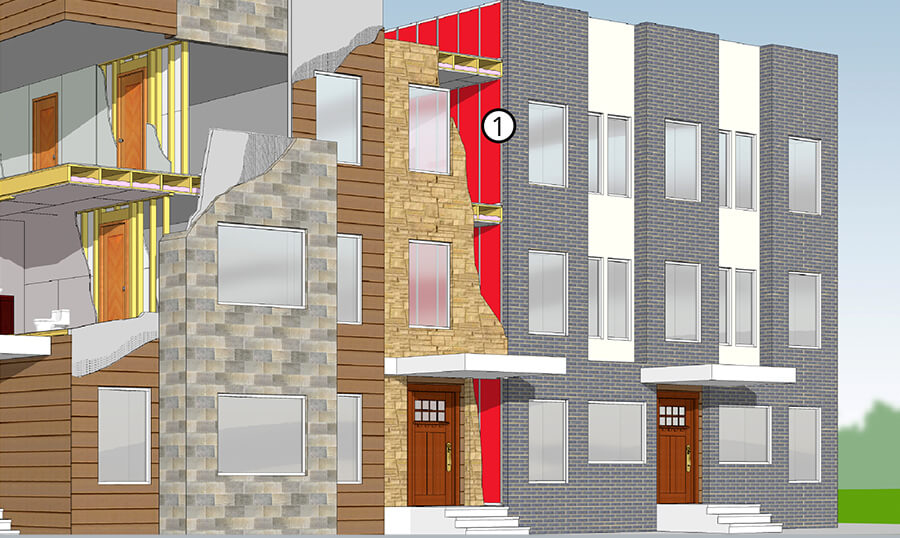Gypsum Shaftliner Panels: Multi-Family Homes
An efficient area separation wall material alternative to masonry

Gypsum Shaftliner Panels bring excellent fire and noise protection to area separation walls
Physical Description
Gypsum Shaftliner Panels are special performance panels that feature a thick, noncombustible Type X core wrapped in either heavyweight paper facers or rugged fiberglass mats. Most shaftliner panels also feature enhanced mold and moisture resistance as a standard product property and beveled edges on the long dimension to aid with installation in metal framing. Gypsum Shaftliner Panels are produced 1” (25.4 mm) thick by 24” (610 mm) wide and 8’ (2440 mm) to 12’ (3660 mm) in length. The applicable product manufacturing standard is ASTM C1396 and ASTM C1658.
Advantages and Benefits
Gypsum Shaftliner Panels have dramatically changed the way area separation walls and access and mechanical shafts are designed and constructed in multi-family structures. Here are several advantages and benefits that make this product an option worth considering:
o Fire Resistance – Area separation walls and shaft walls constructed with Gypsum Shaftliner Panels are capable of achieving a range of levels of fire protection to meet the design requirements of different structures and applications. These 1”-thick, noncombustible Type X panels are UL-classified for use in vertical wall assemblies designed to provide fire-rated values of 1, 2, 3 and even 4 hours. Their tested flame-spread and smoke-developed surface burning characteristics are also extremely low. Refer to GA-600 Fire Resistance and Sound Control Design Manual.
o Construction Efficiency – Gypsum Shaftliner Panels make it possible to build multi-floor area separation walls and shaft wall systems in multi-family structures without the added time, weight and cost considerations of masonry construction. That’s because the assembly of lightweight metal framing is fast and reliable using tools and craftsmen already building other partition structures onsite. Plus, shaftliner panels are available to quickly span the typical height between floors, fit tightly into multiple metal framing systems and allow size adjustments and cutouts to be made easily with a saw or knife.
o Wall Strength – Engineered to handle the stresses, wind pressures and vibrations created by the rapid movement of modern elevator carriages, Gypsum Shaftliner Panels are strong, durable separation wall system components.
o Mold and Moisture Resistance – In the same way Gypsum Shaftliner Panels help protect the tenants of a multi-family housing structure from flame spread, they can also help resist the development and spread of mold and mildew. Both the core and facers of many brands of shaftliner panels are manufactured with moisture-resistant, anti-microbial properties. Consult the manufacturer for specific test results and recommendations.
o Sound Control – Wall assemblies built with Gypsum Shaftliner Panels can be very effective barriers to the transfer of sound vibrations from one space to the adjoining areas within a structure. This is especially valuable when trying to buffer apartment renters in one unit from their neighbors next door or tenants from external noise produced by adjacent equipment, elevators or in stairwells. more
Limitations
To deliver the expected firewall or shaftwall performance defined in a project’s design requirements, a number of basic limitations should be followed. These recommendations are intended to provide general information only about considerations that are common in this category of special performance gypsum products:
o intended for interior use only
o not designed for use in a load-bearing capacity
o not intended for constant exposure to moisture, ponding or cascading water
o avoid exposure to prolonged temperatures exceeding 125°
o maximum height and deflection limits should be based on metal framing manufacturer’s recommendations
o not intended for use as an unlined air supply duct
o board should be stored flat, off the ground, and kept dry prior to installation
Refer to GA-216 Application And Finishing Of Gypsum Panel Products for specific guidelines related to the application and finishing of gypsum panel products.
Products vary by brand. For more specific limitations related to the gypsum panel you are considering, consult with the product’s manufacturer.
Frequently Asked Questions
Below are answers to typical questions our technical experts address on a routine basis. These answers may provide additional information you are seeking as well. To submit an inquiry of your own, click here.
1. Aside from elevator shafts and stairwells, are there other applications for shaftliner? What are some considerations for those applications?
Fire-rated assemblies using shaftliner board can be substituted, within the bounds of the design and code, in many other vertical fire-rated wall and partition applications. Additionally, shafts do not just include elevators, but mechanical raceways and service shafts such as those for laundry or rubbish. In the case of the latter, verify local code acceptability and be aware that these boards can have “rough” surfaces that may slow or stop laundry and rubbish, causing clogs. Lining with sheet metal or other smoother material may be called for by the designer or code official.
For Further Information
To read more about the testing procedures to evaluate the moisture-resistant characteristics of the core and facers of a gypsum panel product, refer to ASTM C473.
To read more about the testing procedures to evaluate the mold-resistant properties of the core and facers of a gypsum panel product, refer to ASTM D6329.
